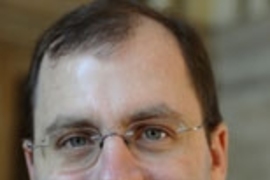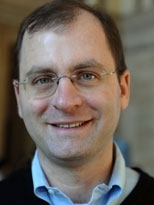A team led by MIT researchers released on Monday, Dec. 15, the most comprehensive independent review of the future of the nation's human spaceflight program undertaken in many years. The report recommends setting loftier goals for humans in space, focusing research more clearly toward those goals, and increasing cooperation with other nations and private industry.
After conducting preliminary briefings with various stakeholders in Washington, team members say it has been enthusiastically received by political leaders, a National Research Council panel, and the Obama transition team, among others.
"We need to rethink the rationales for human spaceflight," says the report's lead author David Mindell, professor of engineering systems and director of the program in Science, Technology and Society at MIT. He says that after the Washington briefings, "we sensed a great deal of uncertainty in DC about how to proceed with the Bush vision and human spaceflight in general. Our paper speaks to those problems in a clear way and offers some new ideas."
The report offers "primary objectives" for sending human beings into space as those that can only be accomplished through the physical presence of human beings and are worthy of significant risk to human life. Says Mindell, "we argue for including notions of risk, human experience, and remote presence into the fundamental rationales for sending people into space. The results show that the United States might want a rather different human spaceflight program from the one now planned."
And it is essential that whatever goals are set for human spaceflight, the funding should be adequate to meet those goals. "Trying to do too much with too little is exactly what caused the last two shuttle accidents," he says.
Â
Among the report's major conclusions are that the United States should be cooperating more on human spaceflight, both with other nations -- including China and India -- and with commercial ventures such as private rocket companies. The nation should also set ambitious goals for long-term exploration, and make sure that near-term work is geared toward those ends. In addition, a comprehensive strategy of basic research is needed to lay the groundwork for these longer-range goals.
Some of the key recommendations from the MIT report:
- Congress and the White House should reduce the "too much with too little" pressure on NASA by ensuring that resources match expectations. They should begin a public conversation on the ethics and acceptable risk of human spaceflight at current levels of support and ambition.
- NASA should continue to support commercial and European development of crew and cargo alternatives, particularly for cargo return.
- The United States should develop a broad, funded plan to utilize the International Space Station through 2020 for research, including development of technologies to support exploration for both moon missions and long-duration Mars flights.
- A new human spaceflight policy should clarify the balance between the moon, Mars, and other destinations. It should be more, not less ambitious. A new policy should also review the Constellation (shuttle replacement) architecture to ensure compatibility with long-range exploration missions.
- NASA should re-establish a fundamental research program focused on science and technology for human spaceflight and exploration
- The United States should begin engagement with China on human spaceflight in a series of small steps, gradually building up trust and cooperation.
The report, called "The Future of Human Spaceflight," was prepared by the Space, Policy and Society Research Group at MIT, which Mindell directs. The group includes MIT aeronautics and astronautics professor and former space shuttle astronaut Jeffrey Hoffman; Apollo Program Professor of Astronautics Laurence Young; Aeronautics and Astronautics Professor Dava Newman; Jerome C. Hunsacker Assistant Professor of Aeronautics and Astronautics and Engineering Systems Annalisa Weigel; lecturer in science, technology and society Slava Gerovitch; postdoctoral associate Scott Uebelhart; graduate students Eph Langford, Teasel Muir-Harmony, Sherrica Newsome, Zakiya Tomlinson and Rebecca Perry; Lawrence McGlynn, president of Insurance Services of New England; Asif Saddiqi, assistant professor of history at Fordham University; John Tylko, vice president at Aurora Flight Sciences; and John Logsdon of the Smithsonian Air & Space Museum.
Reporters can obtain a PDF version of the full report by contacting the MIT News Office or at http://web.mit.edu/mitsps
A version of this article appeared in MIT Tech Talk on December 17, 2008 (download PDF).







